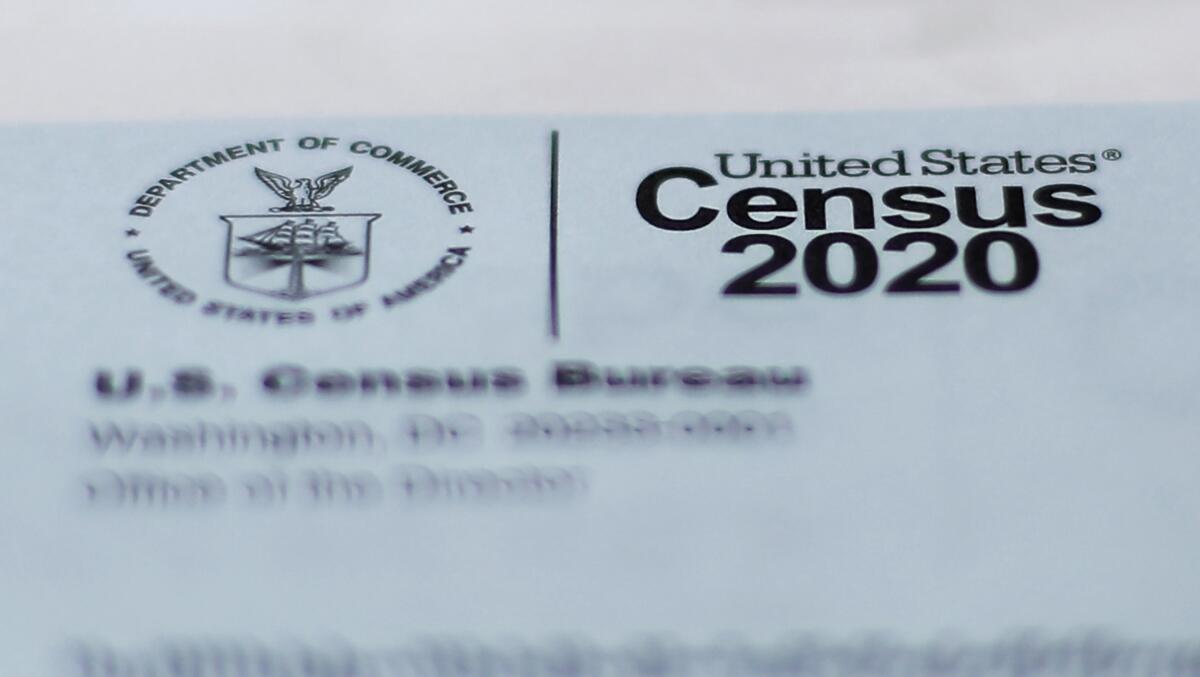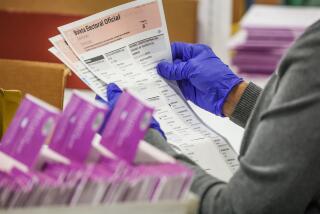Editorial: Why you need to respond to the census (you have the time)

- Share via
Despite the mass disruptions caused by the COVID-19 pandemic, the U.S. Census Bureau continues to forge ahead with the constitutionally mandated decennial count of everyone in the country. It has not been easy. Citing concerns about the coronavirus, the Trump administration has temporarily closed or postponed opening the bureau’s regional offices until June 1, and it has delayed deployment of door-knockers who ferret out hidden populations and encourage residents to turn in their questionnaires. It also has urged Congress to push back the Census Bureau’s reporting deadline from the end of the year to the end of April 2021 to give the bureau some breathing room to conduct as complete a count as possible.
But the key component in getting an accurate count has less to do with the counters than with the counted. We the people need to do better in answering the crucial census questionnaire.
As of Friday, 55.6% of the nation had responded since the first wave of census mailings went out in March. In Los Angeles County, the response rate is slightly lower, at 52.3%, and in the city of Los Angeles it’s lower still, at 45.9%. And those numbers hint at a troubling disparity.
Some higher-income small cities, such as Rancho Palos Verdes, have response rates around 70%. But South Los Angeles and other low-income neighborhoods — which tend to have higher proportions of immigrants — have response rates below 40%. In and around skid row the rate drops to near 10%. A key problem there, of course, is the inherent difficulty in getting census information to homeless residents. But many homeless people and those living on poverty wages also suffer from a lack of internet access, an obstacle in a process that, for the first time, will rely on people filling out the census questionnaires online.
This is just the first wave of the census taking — but it’s among the most important. Notices went out in March inviting people to log on to my2020census.gov and answer a dozen questions about where they were living on April 1 (the official census day), their household size and some demographic details. Those questions can also be answered over the phone, at (844) 330-2020, or by filling out and mailing back a printed questionnaire, which tends to be sent to the households of people who have not responded online. Either way, the process takes minutes.
Households that fail to respond through any of those avenues eventually will be visited by official census takers. Which means, obviously enough, that the more people who respond to the census now, the fewer people census counters will need to bird-dog in the coming months. Given the risks of spreading COVID-19, it is vitally important that people take the initiative to respond online, via phone or through the mail to preclude the Census Bureau from having to send workers around to conduct face-to-face interviews. It’s silly to entertain that risk during a pandemic when it can be forestalled by simply responding through one of the no-contact avenues.
Why is this so important, especially in hard-to-count neighborhoods of immigrants and low-wage workers? Around $1.5 trillion in federal spending is distributed each year using formulas that incorporate census data, including payments for Medicare and Medicaid, programs funded through block grants, Head Start and the National School Lunch Program, among many others. Clearly, many of those programs have significant effects on low-income communities — the very places where census participation traditionally is lower.
Congress also uses the results to reapportion seats in the House of Representatives for the next decade. In a transparent ploy intended to dissuade immigrant households from cooperating with the census, the Trump administration sought to add a question asking the citizenship status of everyone in a household, ostensibly to collect data that could help enforce anti-discrimination laws. Bear in mind that about a quarter of the nation’s 44 million immigrants are living here without permission. Immigrant communities tend to live in urban areas and support Democratic candidates, so adding the question could have tilted legislative and congressional elections for the next decade in Republicans’ favor. Fortunately, even this conservative Supreme Court saw through the ruse and barred the question, but a part of the population already suspicious of the federal government has become even more so.
An undercount in immigrant neighborhoods in a state with more immigrants than any other has a related and unwelcome consequence. Given the nationwide shifts in where people live, California is already poised to lose at least one House seat in the next reapportionment. That becomes even more likely if the California population is undercounted. So it is vitally important that everyone — particularly here in California — work with the Census Bureau to get this right.
More to Read
A cure for the common opinion
Get thought-provoking perspectives with our weekly newsletter.
You may occasionally receive promotional content from the Los Angeles Times.










